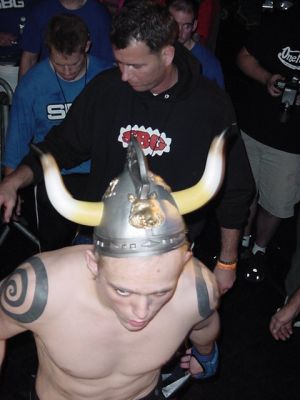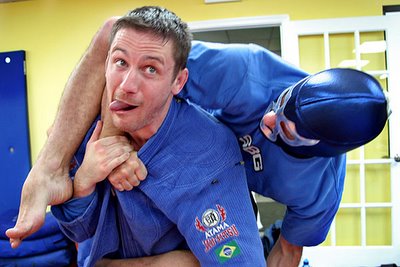An essay originally published in January 09, 2006

A few months ago I was watching the mat during one of my BJJ classes at the Portland gym. We were now towards the later end of the class where we roll with each other. As I was standing on the mat, watching that everyone rolling was safe, and coaching periodically. I noticed one of the newer students off on the edge. He had only been in the gym for a few weeks and a more experienced, aggressive player was smashing him on bottom. He wasn’t being hurt, and nobody in my gym ever comes at someone else with intentions of hurting them, but he was being crushed. His arms where trapped, his head was pinned to the side, his cheeks and face being smashed down into the mat. I could see that he was beginning to have trouble breathing. I knew well every single little pain he would have in his neck and shoulders after being pinned in a position like that.
I am not sure he had ever been in such an uncomfortable position before. Having done BJJ for around thirteen years or so, I have been in that and dozens of other equally uncomfortable spots, thousands of times; as all of us who play this sport for more then a few years have. For him, it was, clearly, a new thing.
I could tell he was on the verge of tapping out, then he would find a way to get breath, move just an inch, and would hold out longer. A few seconds later, I knew I would see his hand ready to tap, again. He had a look of real “oh shit” despair in his eyes; part panic, part ego, and I knew that very well, also.
Then, with a fairly sudden explosion of movement, he was able to make space and bring his knees to chest, pulls back a guard, sweeps, and ends up on top of his opponent, who was clearly surprised.
Just at that exact instant, I observed the look in the eyes of the student who had reversed that particular position, and I saw a rush of authentic joy. It wasn’t Mount Everest, it wasn’t the Olympics, or the UFC but, for this guy, it was still a huge thing.
It is a scene that gets repeated hundreds of times a day in my gym. It goes unnoticed by most of us involved, most of the time, because it is just another day for us. It is an amazing process, nonetheless.
The old games will always be with us:
Spontaneity vs. Control
Freedom vs. Structure
Love vs. Isolation
-Tim Leary
What I realized better after that day was two things:
The first is that the rush of joy that the athlete experienced at that moment didn’t just come because of a success on the mat but, instead, that the success on the mat had served as a vehicle for a different understanding, and that this understanding was actually a certain kind of pleasure that only comes in moments where you learn something new about yourself. It is where you have discovered it, through trials and risk, and made it through to another side.
The second thing I realized is this: that I, as a coach, had little to do for that process, beyond my role in creating a safe and healthy environment that allows its frequent occurrence.
I have observed the full spectrum of coaches over the years and I have played from several extremes, myself. I have been that coach that demanded a highly intense practice and work ethic, both of myself and of my students, because I felt that was the only way to go.
Then, having taken that end to an eventuality, I realized that the process I had been advocating was itself not enough for me, and therefore, how could it be enough for someone else? It was the second part that caught me. From that perspective I took another extreme, which demanded nothing beyond what was casually given at the time. Sometimes it was because I didn’t want to push into the darker, self-centered side, of this particular trade, because I had personally been there. Sometimes, I was just lazy.
“If you act from fear there is no way you can receive love because you are trapped in a thought about what you have to do for it.”
– Byron Katie
Most recently I have begun realizing that good coaching demands that I make no such decisions regarding extreme ends of the fascist – slacker coach paradigms. What I believe I see is that my job is just to be present, transparent, and sincere in my efforts to honor the process.
Honor the process, not create, mold, manipulate, buy, sell, trade, own, or tweak the process; just honor the process.
If I did that, the process would take care of everything else and it would do it far better than I could ever be capable of doing.
I think Joseph Campbell described this kind of journey really well when he said that each individual must follow his or her own bliss.
au•then•tic•i•ty: n. the quality or condition of being authentic, real, genuine.
I have heard people interpret that as selfish but it only appears selfish from a particularly restricted point of view. The restriction is that what you feel may bring you bliss, may also be potentially unhealthy for you and others around you. I do think that can, often, be true.
However, should we see past that stage, and perhaps no longer find those potentially dangerous habits as ‘healthy’ and lacking in joy. When we have fully realized the areas, shadows, and spaces where suffering was involved for all kinds of people, I believe we grow tired of it. That happening may very well come to you as the thought, “This does not make me happy, this cannot be following my bliss!”
After all, BLISS is a huge word. It’s loaded with all kinds of very cool sensory implications. So it spurs that idea, “Hey, it must be more than this!” and that brings about changes in the entire scene.
Changes for the good, spaces for the happiness, and much – much more.

“Sometimes, in a dynamic individual, the whole being senses that the static situation is an enemy of life itself. That’s what drives the really creative people – the artists, composers, revolutionaries and the like. The feeling that if they don’t break out of this jailhouse somebody has built around them, they’re going to die.
They’re fighting for some kind of dynamic freedom from static patterns.”
– Pirsig
As a coach, I see our real jobs as just being there to help each individual take this journey in exactly the way they need, and for exactly the amount of time they take. No more, no less.
Recognizing fully that, sometimes, to truly help other people, we have to let them continue in a path whose outcome we may already know well. We can understand that sometimes the greatest aid you can be to someone else is to help show them how take care of themselves. While at the same time, offering a hand every time they can’t.
If asked how we will know when someone can’t do something, as opposed to when they just aren’t doing something, I would offer that observations from personal experience will help us distinguish between the two, and that is why coaches often get better at their trade as they age. *
*(Note this doesn’t mean they ‘should’ follow a certain path at a certain time, or if they will. It only means that others have already done so many times. We recognize it may be more likely a certain way.)
The observation made may be drawn from our own personal experiences of the process, and these are often very valuable. Those, although sometimes vivid in a different way, are not nearly as numerous as the ones we will make time and again as different students, with vastly different backgrounds, and often different agendas, engage in the process in different ways. Those experiences, if truly observed, recognized, noted, and contemplated, are in my opinion the very acting processes of evolution itself.
Then I remember that, going into the gym and coaching our students isn’t just another day at the office, or even a career, but rather a great privilege.
We recently had someone drop into our Portland ICC class, and this was a comment made about that experience online:
“I had a chance to work out a bit with the Portland ICC class (instructor candidate course). I had been hearing for a while what a great group this is and was blown away by the work ethic I saw. The coolest thing was all the inquiry peer-coaching going on. A lot of times people come in for class and mill around until the instructor gets everyone out on the mat. Not this group. People came in, changed into their workout gear, grabbed a partner and started working on different parts of their game right away. There were guys working boxing in one corner, other guys with MMA gloves on working striking from the clinch. There were a few guys working out some attacks from the turtle position etc. No one was waiting around for Matt to tell him or her what to do. It was beautiful peer coaching going on everywhere. I can’t tell you how cool this was to see. As a teacher, by profession, I love to see this type of peer coaching going on and I realize how rare this type of thing is. Cool stuff, Matt, you must be proud of those guys.”
To remain in line with that sense of sincerity I had to make sure that what I was teaching in terms of curriculum was Alive. Although I believe that is absolutely important if the trade you desire engaging in involves some form of combat or competition, (I believe all trades need to be authentic or they will fail in terms of bringing real joy) that does not mean that there is still not much more to learn, do, observe, and understand about just being present with people, in a clear, compassionate, and honest way.
This, the, so-much-more-to-learn part, that is the part that makes the “trade”. In this case, teaching people fighting skills that are meaningful, healthy, and rewarding.
I believe that understanding that, feeling it, living that, and observing that is truly what honoring the process means. I believe that honoring the process may be the most important thing we do when we wear a hat that says “Coach”.
“The joyous task which confronts an ethic of spontaneity, however difficult it may be, is quite literally to woo people out of their armed shells.”
-Alan Watts








